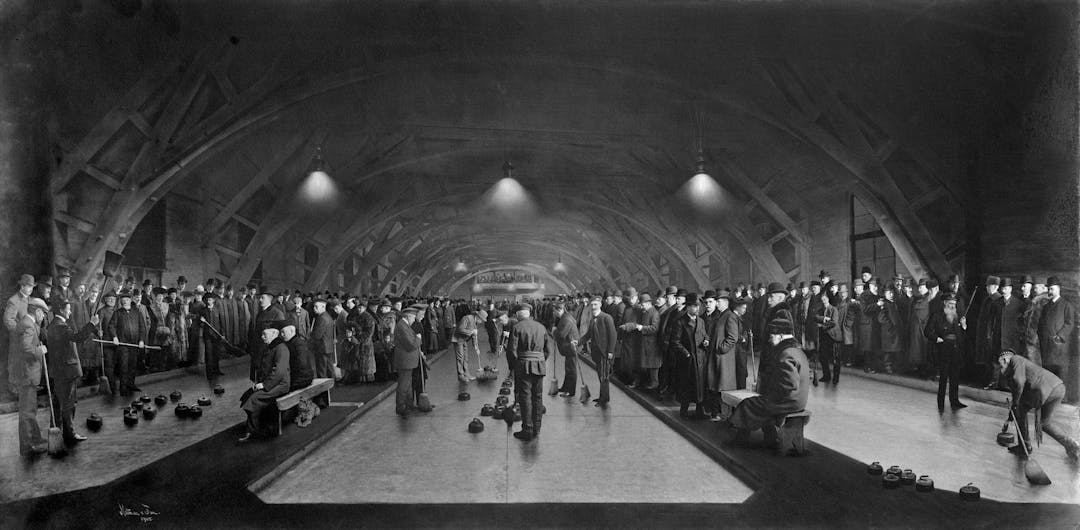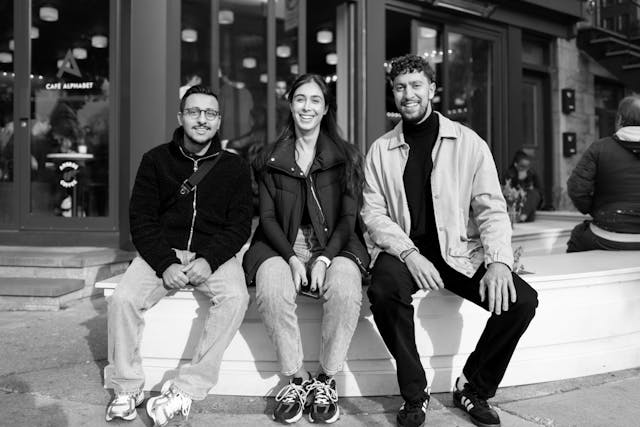Age, grace & ice: The Royal Montreal Curling Club, North America's oldest sports club
The oldest established and active sports club—let alone the oldest curling club, period—on the entire continent is right here at home.
 Curling in Canada, Montreal Curling Club, Montreal, QC, 1905, copied about 1906 | Photograph: Wm. Notman & Son / Notman Photographic Archives via McCord
Curling in Canada, Montreal Curling Club, Montreal, QC, 1905, copied about 1906 | Photograph: Wm. Notman & Son / Notman Photographic Archives via McCordCurling is… how can we say this?
Curling seems like it’s a non-sport to some.
Maybe it’s just us, but we’re not seeing the pubs in town fill up when a gold medal’s on the line at the Olympics. The shouting over people furiously brushing away at ice over thrown stones as they slide across ice, even if it’s considered to be a national pastime, doesn’t seem to be taken as seriously as it should be.
When we learn, however, about places like the Royal Montreal Curling Club?
We do a double-take.

Back to the ice age
Established on January 27, 1807 by a group of Scottish Canadian immigrants in Montreal, the Royal Montreal Curling Club (RMCC) is the oldest sports club in North America. According to The Ultimate Canadian Sports Trivia Book, the group behind its first league would meet at the Gillis Tavern to lay down the rules of the organization—kind of cool for its time, as taverns back then could be seen as underbelly spots that were sources of crime.
Thirty years later, the group would again make Canadian sports history, by building Canada's first indoor ice rink.
To give you an idea: Back then, Canada was characterized by a diverse tapestry of Indigenous nations coexisting with burgeoning European settlements. The eastern provinces, part of the British Empire, were marked by growing cities like Quebec and Halifax. Agriculture thrived, with farms cultivating diverse crops. Slavery was present, though less pervasive than in the southern neighboring regions. Transportation relied on horses and rivers, while nascent industrialization and technological advancements began shaping urban landscapes.
Cultural life was influenced by a mix of Indigenous traditions and European customs. Canada's social fabric, caught between colonial ties and burgeoning identity, reflected the complexities of a rapidly changing North America.
And then there was curling, a sport that originated in medieval Scotland and involved sliding stones on a sheet of ice towards a target area. Played in since the 16th century, it didn’t gain widespread popularity until the time it came to places like Montreal when the formal establishment of indoor curling rinks started to develop.
In 1807, people would normally play a more informal version of curling on outdoor natural ice surfaces like frozen lakes or ponds. The game might have been less structured, and the rules could have varied from one community to another. Equipment and facilities would have been rudimentary compared to modern indoor curling rinks.
Place like Montreal’s club were part of a growing development of dedicated indoor curling rinks with standardized ice surfaces and organized leagues that spread into the 20th century.

Building a monument
Back in 1860, what was then called the ‘Montreal Curling Club’ decided to ditch the outdoors and set up shop in an indoor rink on Drummond Street, right around where the Mount Stephen Club stands today.
Fast forward 28 years, and it snagged its current-day spot on Saint-Catherine Street West between St. Mathieu and St. Marc for a brand-new curling shed, opening its doors in 1889 and being a go-to rink ever since.
The next year, part of its land was sold for a lot on the other side (then 56 St. Luke Street which is today’s 1850 Boulevard de Maisonneuve West) to build a clubhouse: It was designed by Hyde & Nobbs, an architectural partnership consisting of Percy Erskine Nobbs and George Taylor Hyde; Nobbs designed many of what would become Montreal's heritage buildings—the Redpath Library Building and Osler Library of McGill, among others—and was a key Canadian proponent of the Arts and Crafts Movement in architecture which sought to reform design and decoration in mid-19th century Britain to produce things which were novel and intelligent, sometimes simplified, yet beautiful.
Built in the style of the famous Victoria Arena (where the Montreal Maroons later played hockey), with laminated wood and arched girders, it still stands today. If you visit, its huge space absent of pillars is unique in the city and the only one of its kind still hanging around.

Swept away
The club kicked off in its current-day formal manner on Christmas Eve of 1892 and got an upgrade in 1912. While its doors have “always been open to men and women,” as their history reads, the Ladies’ branch of the club has been ongoing since 1894, taking charge of leagues and hosting events.


Leslie group (office staff), Montreal, QC, 1904 (left) and Miss V. Allan and Mrs. Russell Stephenson curling, composite, Montreal, QC, 1876 (right) | Photograph: Wm. Notman & Son and William Notman Studio / Notman Photographic Archives via McCord
Then, on February 23, 1924, the club got a Royal Warrant, officially adding "Royal" to its name: Say hello to today’s Royal Montreal Curling Club.
Now, over the last 30 years, a bunch of other curling clubs in Montreal and Westmount have called it quits – Heather in '75, followed by Montreal Caledonia and Greystone in '82, then St George, and in 2001, the Thistle Curling Club.


Opening of Montreal Caledonia Curling Club, Montreal, QC, 1869 (left) and Thistle Curling Club group, Montreal, QC, 1893 (right) | Photograph: James Inglis & Wm. Notman & Son / Documentary Collection and Notman Photographic Archives via McCord
The RMCC is still standing though, the only downtown curling spot left, as a heritage monument and a true Canadian curling shrine.
Today, it boasts a grand 3-sheet ice rink and its own club house with a full-time staff including a general manager and chef and bar services manager; games and events are often preceded or highlighted by dining and drinking events. The bartenders will do a heavy pour of Johnnie Walker, the kitchen makes some good food—we're not talking poutine and burgers, but proper dinners—and the atmosphere's both refined and fun.
A lot of Montreal's private clubs are often behind the scenes of places like the Golden Square Mile, but this one's out in the open and ready to receive players during the colder seasons. It doesn't run all year as the heritage structure isn't equipped for ice in the summer, but damn—is it ever cool to think about and be inside of.
Corny, we know, but it truly is an often underrated local treasure.

The Royal Montreal Curling Club is located at 1850 Blvd. De Maisonneuve Ouest in downtown Montreal—doors are always open to new members.

![The Bulletin: This newsletter's very glou-glou 🍷🍇 [Issue #51]](/_next/image?url=https%3A%2F%2Fthemain.ghost.io%2Fcontent%2Fimages%2F2023%2F11%2Fbarvinvinvin_382466665_18069895342418831_5200366361578870037_n.jpg&w=640&q=75)